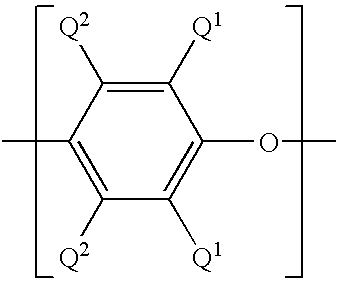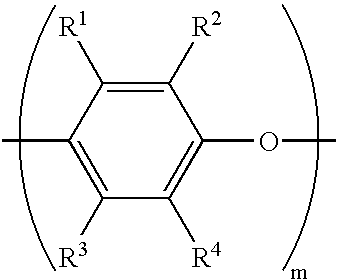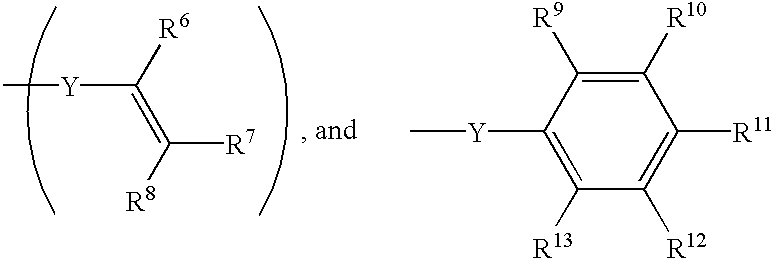Poly(arylene ether)-containing thermoset composition in powder form, method for the preparation thereof, and articles derived therefrom
- Summary
- Abstract
- Description
- Claims
- Application Information
AI Technical Summary
Benefits of technology
Problems solved by technology
Method used
Image
Examples
example 2
[0087] The procedure of Example 1 was repeated, varying amounts of diallyl phthalate (600 grams), methacrylate-capped poly(2,6-dimethyl-1,4-phenylen-e ether) (250 grams), and trimethylolpropane trimethacrylate (150 grams). The compression molded sample was a solid transparent disk of nominal dimensions 3 inches diameter and 0.125 inches in thickness. Hardness and toughness tests conducted after further curing, as described in Example 1, showed the molded sample to be hard and tough.
example 3
[0088] The procedure of Example 1 was repeated, varying amounts of diallyl phthalate (550 grams), methacrylate-capped poly(2,6-dimethyl-1,4-phenylen-e ether) (300 grams), and trimethylolpropane trimethacrylate (150 grams). In this example, the methacrylate-capped poly(2,6-dimethyl-1,4-phenylene ether) had an intrinsic viscosity of 0.30 dL / g and was prepared using the same procedure used to prepare the 0.25 dL / g material. The compression molded sample was a solid transparent disk of nominal dimensions 3 inches diameter and 0.125 inches in thickness, being substantially hard and tough. Hardness and toughness tests conducted after further curing, as described in Example 1, showed the molded sample to be hard and tough.
example 4
[0089] A quantity of 9 grams of the powdered resin described in Example 1 was dry blended with 10 grams of silicon carbide powder having a grit size of 500 and 31 grams of silicon carbide powder having a grit size of 150. This resin / abrasive blend was then compression molded for 15 minutes at 155.degree. C. and a pressure of about 2000 psi using methods known to those skilled in the art. The resultant specimen was a solid disk of nominal dimensions 3 inches diameter and 0.125 inches in thickness, being substantially hard and tough. Using the same blend of resin / abrasives, two more specimens were molded, each resulting in a substantially hard and tough material. Hardness and toughness tests conducted after further curing, as described in Example 1, showed the molded sample to be hard and tough.
[0090] It should be noted that the chemical components of the resin composition allow it to be cured without generating volatiles. This advantage is not shared by phenolic resins, the curing of...
PUM
| Property | Measurement | Unit |
|---|---|---|
| Percent by mass | aaaaa | aaaaa |
| Percent by mass | aaaaa | aaaaa |
| Percent by mass | aaaaa | aaaaa |
Abstract
Description
Claims
Application Information
 Login to View More
Login to View More - R&D
- Intellectual Property
- Life Sciences
- Materials
- Tech Scout
- Unparalleled Data Quality
- Higher Quality Content
- 60% Fewer Hallucinations
Browse by: Latest US Patents, China's latest patents, Technical Efficacy Thesaurus, Application Domain, Technology Topic, Popular Technical Reports.
© 2025 PatSnap. All rights reserved.Legal|Privacy policy|Modern Slavery Act Transparency Statement|Sitemap|About US| Contact US: help@patsnap.com



